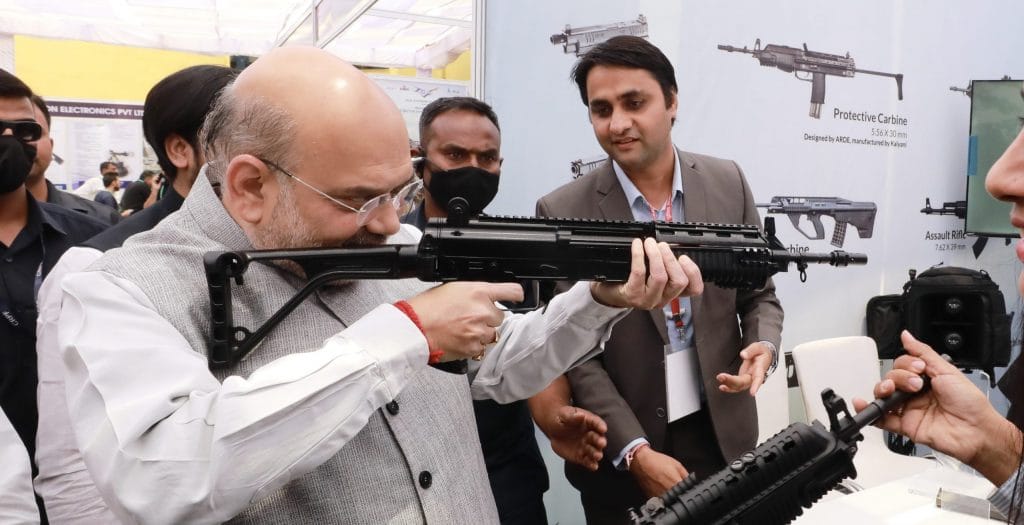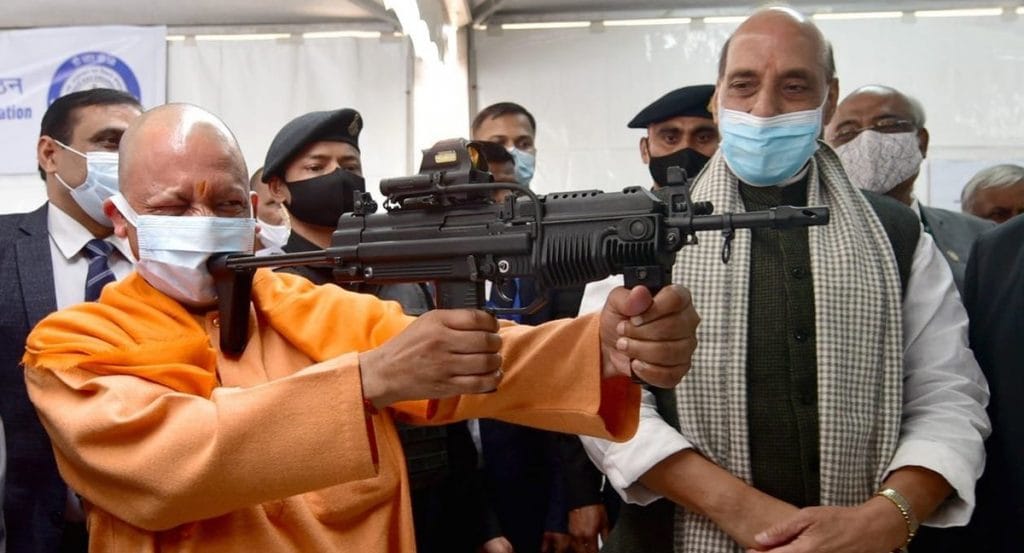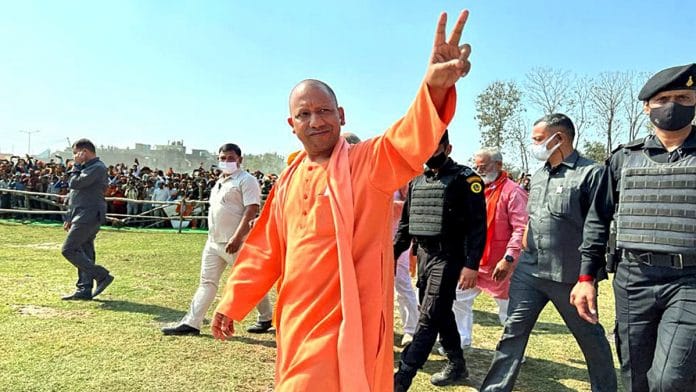There was something familiar about Union Home Minister Amit Shah’s picture at the All India Police Science Congress meeting in Bhopal on Friday. He was holding a joint venture protective carbine, taking aim with a finger on the trigger.
Déjà vu? Sort of. Remember Uttar Pradesh chief minister Yogi Adityanath holding a rifle and taking aim at a Defence Research and Development Organisation (DRDO) exhibition in Lucknow last December? “Cheeteh ki chaal, baaj ki nazar, aur Yogi ji ke ‘nishaane’ par sandeh nahin karte (Never doubt a cheetah’s speed, a hawk’s eyes, and Yogi ji’s target),” the UP unit of the Bharatiya Janata Party (BJP) tweeted that day. The ruling party’s tweet put ‘nishaane’ under single inverted commas. His finger was not on the trigger though.


Similarity between the two pictures could be coincidental, for sure. But these images carry a message at a time when bulldozers — politically patented by Yogi — are becoming the BJP’s mission statement. Given how closely Amit Shah monitors the Delhi Police and civic bodies, the use of bulldozers in Jahangirpuri amounts to the Centre adopting Yogi’s stylebook of governance and politics. It is, therefore, no surprise that the BJP-led governments in states, which earlier followed the ‘Gujarat model of development’, are now turning to the ‘Yogi model’. The BJP-led Madhya Pradesh and Gujarat governments beginning to use bulldozers and Karnataka and Uttarakhand vowing to follow suit is only illustrative.
The irony is that when top BJP leaders — from the Union Home Minister to chief ministers — have started following the ‘Yogi model of governance’ (or whatever it means to them), the UP CM is focusing on the ‘Modi model’ of Gujarat.
Exactly a month after he took oath as CM for the second time, Yogi 2.0 is looking distinct from Yogi 1.0. His first term in office was marked by a persistent endeavour to crystallise his image as a Hindutva warrior seeking endorsements from the Rashtriya Swayamsevak Sangh (RSS) and the core base of hardliners. There were highways, investment and development figures, crime statistics and Covid-19 data to talk about. These figures and data were official, of course. Anyway, they were meant to feed into the principal narrative, and it worked.
Also read: Many in race to be Modi’s successor but here’s one who can step into Amit Shah’s shoes
Taking a serious turn
The last four weeks of Yogi 2.0 have been serious attempts to identify priorities, if not course-correct. Lots has been reported about how the UP CM is keeping his ministers and officials on toes.
He has been setting priorities and agendas at a hectic pace.
Even before taking oath as CM for the second time, Yogi initiated the process of appointing a consultant to make UP a trillion-dollar economy. If some sceptics were not impressed, blame it on the Yogi government’s track record. After all, its tall claims of development (freebies aside) got little endorsement from the people on the ground when hordes of reporters descended in UP villages to cover the assembly elections. The government advertisements made big claims about employment generation, while students and youth heard it all in dismay. But for Mayawati’s retreat and Akhilesh Yadav’s invisibility for most of Yogi’s term, the latter would have found the going tough.
As much as he owes it to Modi and Yadav for different reasons, Yogi Adityanath has learnt hard lessons from this election. Or so it seems from the way he is dealing with issues in the second term. It’s curious that the Vishwa Hindu Parishad (VHP) and Bajrang Dal activists went into hibernation in Uttar Pradesh when their counterparts in Madhya Pradesh, Delhi, Gujarat, and even Odisha were carrying out Ram Navami and Hanuman Jayanti processions. This was something one witnessed post-2002 in Gujarat when Narendra Modi was the CM.
After the communal clash in Delhi’s Jahangirpuri, Yogi Adityanath held a meeting with police officials last week. He cancelled the leave of police and administration officials in view of Eid and Akshay Trititya, likely to fall on the same day. Among other things, he instructed them to take an affidavit from the organisers of processions to maintain peace.
As tensions were building up with Right-wing groups planning to play Hanuman Chalisa on loudspeakers at the time of azaan, Yogi issued instructions to limit the sound within the premises. Many mosques and temples — including the Gorakhnath Mandir and Mathura’s Shri Krishna Janmasthan temple — have removed loudspeakers or lowered the volume. The police have also swung into action, cracking down on such loudspeakers. No prize for guessing who could be at the receiving end.
The Akhil Bharatiya Vidyarthi Parishad (ABVP), the RSS’ student wing, had declared a plan to set up 21 loudspeakers at crossings in Aligarh to recite Hanuman Chalisa as a way to protest against azaan. After a few days, the ABVP dissociated itself from the move.
Also read: Bolder, sharper, more assertive — What Uttar Pradesh can expect from Yogi 2.0
Word on CAA, UCC
Reining in VHP and Bajrang Dal activists in UP, just like Modi had done in Gujarat, is a significant indicator of how Yogi is trying to chart out a different path in his second term. Also, have you noticed he has been rather unspectacular in the last six weeks, quite a change from his one-controversy-a-day image earlier? He seems to be serious about getting big-ticket investments in UP and making it a trillion-dollar economy. And the last thing he would want is communal riots or law and order problems.
But he has testing times ahead. After a long gap, Prime Minister Narendra Modi broached the Citizenship Amendment Act (CAA), 2019, hailing it for giving citizenship to religious minorities facing persecution in neighbouring countries.
Amit Shah also referred to the CAA in Bhopal on Friday. It has been over two years since Parliament cleared the citizenship law, but the home ministry hasn’t notified the rules yet. If the PM’s and the HM’s recent remarks about the CAA are any indicators of the Centre preparing to finally bite the bullet, the Yogi government, which had come down heavily on anti-CAA protestors, would have its work cut out. The Uniform Civil Code (UCC) is also back in the political discourse, with Shah referring to it in an interaction with party leaders in Bhopal. It was followed by UP deputy CM Keshav Prasad Maurya claiming that his government is considering the implementation of the contentious UCC.
Although Yogi has been a strong advocate of the UCC, he has been non-committal on the timing of its implementation. In an interview with The Economic Times last month, he said, “We can’t implement personal laws and faith. The issue of the UCC will be taken up at the right time.”
The CM sounded tentative about the UCC rollout in that interview, which came days before the UP poll outcome. One doesn’t know if Maurya, who doesn’t have a great rapport with Yogi, had the latter’s sanction to say what he said about the UCC. But Shah’s remark was a signal from the Centre to the BJP-ruled states to follow the Uttarakhand lead on UCC. Although the RSS is said to have reservations about the immediate implementation of the UCC, the Sangh Parivaar is waiting for the report of the Uttarakhand committee on the UCC before taking a final call.
If the Sangh gives a go-ahead for the UCC, Uttar Pradesh and other BJP-ruled states would soon have to follow suit. Yogi Adityanath has been attempting an image makeover in the past month, but how long he would be able to keep the genie in the bottle is a million-dollar question.
DK Singh is Political Editor, ThePrint. He tweets @dksingh73. Views are personal.
(Edited by Humra Laeeq)






